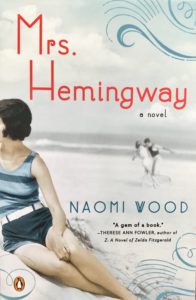Ernest Hemingway maintained that the mark of a good writer was the ability to focus on key details, those unique, perhaps evocative, observations that would stand out and render each scene more memorable. (For example, Hemingway’s reference to the ‘clean whiteness of the thigh bone’ in his description of the wounded matador —page 20 of Death in the Afternoon, later recalled in Ernest Hemingway on Writing, edited by Larry W. Phillips). In her enchanting and highly readable novel, Mrs. Hemingway, author Naomi Wood puts Hemingway’s dictum into practice. The novel is dotted with little gems of description. Examples from Mrs. Hemingway include the ‘dusty mule sausages’ when referencing the Spanish Civil War, how ‘green light filters through’ the opened bottle of champagne in Hemingway’s room at the Paris Ritz, and how Hemingway’s last wife, forced to improvise when applying her make-up in wartime London, had ‘worked up burnt cork with some water for her lashes.’
Hemingway believed that, to be a writer, one had to live the ‘writer’s life,’ meaning, for him as a man, one had to go to war, to attend bull fights, to box, and to drink large amounts of alcohol. He had four wives in total and, despite the title of Naomi Wood’s Mrs. Hemingway being in the singular, the novel spans all four: Hadley (‘The Paris Wife’ and mother of Bumby), Fife (the writer for Vogue whose real name was Pauline; she showed up in Paris and stole Ernest away), Martha Gellhorn (the war correspondent from both the Spanish war and World War II), and Mary (the American journalist who, like Martha, had experienced the war in Europe).
Naomi Wood leaves no alleyway unexplored: the salon of Gertrude Stein, for example, or the bookstore, Shakespeare and Company, beloved not only of Hemingway but also of writers such as James Joyce and F. Scott Fitzgerald. Wood leaves no stone unturned, notably the issue of Hemingway’s suicide. She covers locations—Paris, Key West, Cuba, Idaho—in order, and the reader experiences the great writer from the point of view of each wife, in turn. Wood’s novel will delight fans and would also be an interesting introduction to Hemingway for those who have never read his work.

